Welcome to the eighth instalment of Monday #MusicMatters as part of the JAMS Canada PRO Series – “Here’s What I Know”.
We caught up with Rob Kellough for his insight about working with Sound Engineers
What are the top 3 things a musician should do to maximize their sound check allotted time?
Be prepared. Be professional. These are the two most important things an artist can do and they touch on everything I am going to talk about.
Here are three things you can do to prepare that will always make a sound tech smile (yes, they do actually smile from time to time).
- A set list. Just a list of the songs in proper order with any useful notes added for each song if needed.
- An input list. This is a list of the required inputs on the mixing console that the act wants as well as information about that input. (e.g. “Channel 1: Vocal mic, Shure SM58, boom stand. Channel 2: Acoustic guitar, DI box”, etc.). Make sure to specify whether the venue or the artist is to supply the item. Many acts use a spreadsheet as a handy way to create an input list.
- A stage plot. This is an overhead diagram of how the artist(s) set up on the stage. It should show each performer station with the associated inputs as well as the position of the wedge monitor(s) and location of required AC power. It also specifies how many monitor mixes are required and in what order. Some even provide rough guidelines as to what the performer likes to hear in their mix (e.g. lead vocals, piano, no drums). Note that these are subject to change during the sound check, but it does help speed up the process.
All this may sound like overkill and it may not be necessary for every gig, but when you can present a venue sound person with clear concise information it will make for an efficient sound check and a good performance. I don’t know any tech that dislikes getting lists and plots. It does require some thought and effort to prepare, but the process will help you streamline your setup and performance. A fast sound check is a good sound check…for everybody.
Remember to keep all your lists and plots up to date and if you have more than one set up, make sure you send the correct one (yes, this has happened).
Here are ways you can approach your sound check in a professional manner.
Be on time. Even better, be early.
Bring everything you need for the gig and know how to set up quickly and efficiently.
The sound tech is counting on you to tell them if you’re happy with the sound on stage. Be as specific as you can. Phrases like “I just don’t like the way it sounds” are not helpful. Saying “My vocals seem a bit boomy, give me a little mid-range vocal boost or can you bring down the guitar and bass a bit in my monitor mix?” will give the tech a better idea of what you’re looking for.
If the sound tech asks you if could reduce the volume of your amp (Guitar/Bass/Keyboard) a bit, don’t be offended. They are trying to balance the sound in the room so that YOU sound great. It’s awesome when a guitarist asks “Am I too loud?” because it means they care about the quality of the overall performance.
What are some of the challenges you face when doing sound for a variety show or several acts? How can musicians help make their sound check spot go smoothly?
For festivals and variety shows all bets are off in terms of the usual live performance setup routines. There’s just no time for any fancy setup between acts. Unless you’re the headliner, you probably won’t get a proper sound check. You’ll get what’s called a line check where the tech will confirm signal from your mics and instruments. You will probably have to make do with a generic monitor mix. The old joke is that your sound check is your first song. The longer you take to get up and going, the more annoyed the techs and stage managers will become because it pushes the event overtime. If you have 10 acts that are each just 5 minutes late in starting, the festival will run almost an hour late!
Here are a few tips.
- Show up early and talk to the sound tech and stage manager in advance about what you need and what they have to give you. Be ready to adapt.
- Don’t disappear until just before you’re scheduled to perform. Stuff happens, acts run short or long. Lineups can change. You may be asked to add a song or drop one. You may be asked to move up or down in the lineup. None of this can happen if the organizers can’t find you.
- Remember the K.I.S.S. rule. If possible, pare your setup back as much as possible. Less time setting up means more time performing.
- Although it isn’t always possible or practical, if bands can share backline amps and drum kits it speeds up the changeover considerably. If you’re open to this idea tell the stage manager or sound tech.
What are your top annoyances/pet peeves when doing sound for an act? What can they do to help you help them sound the best they can.
1) Missing or faulty gear, including (but not limited to) capos, strings, picks, batteries, power supplies and guitar/instrument cables. Providing these is the responsibility of the artist, not the sound tech. Have at least one spare for everything. Imagine the worst-case scenario and prepare for it, because if you don’t, it will almost certainly happen to you one day.
2) Sound check is NOT a rehearsal. Sort out your performance on your own time. Nothing aggravates a sound person like a sound check that runs into their dinner hour.
3) Backing tracks (shudder). If you must sing to a track, verify in advance with the sound tech that the track will play on the venue sound system. Nothing will ruin everyone’s day like when a CD or USB drive won’t read or a cell phone that unexpectedly locks itself. Not cool.
4) No, you can’t borrow my gaffer tape. (Old sound tech joke)

What sound engineering tips can you share with musicians when they have to do their own sound?
Performing and doing your own sound is extremely challenging. How can you hear what it sounds like in the room when you’re the one playing it? Having an extra set of ears to listen from the audience is great, but it isn’t always possible. The new generation of tablet controlled digital mixers are something of a breakthrough for these situations since they allow the musician to walk around the room and adjust things on the fly. They can even allow you to record and playback your material while you adjust the room sound to your taste. There is a fairly steep learning curve to using these mixers, but they offer great bang for the buck.
How has COVID 19 impacted your life?
I’m basically retired, so fortunately for me, not much. I know it has had a devastating impact on live music and all the trades and businesses that are associated with it. We will see the ongoing effects of the pandemic for years to come and sadly there will be artists, events, festivals, venues and businesses that won’t survive this disruption. That is truly tragic.
Bio
Rob Kellough is a co-owner of Through The Cedars Music Productions with Paul Johnson. Over the years Rob has done sound for just about everything from local amateur talent contests to Grammy and Juno award winners. He has been a sound tech for the Prince Edward County Jazz Festival since 2005.
Facebook: @robkellough
______________________________________________________________________________________________________
Look for more JAMS Canada PRO Series “Here’s What I Know” Monday #MusicMatters here on our website and on Facebook, Twitter, Instagram and Linked In.
Some contributors also responded with videos – please subscribe to our JAMS Canada YouTube channel: https://www.youtube.com/channel/UC-CmaB7MV0r1ehhveBPmBEg


Trackbacks/Pingbacks